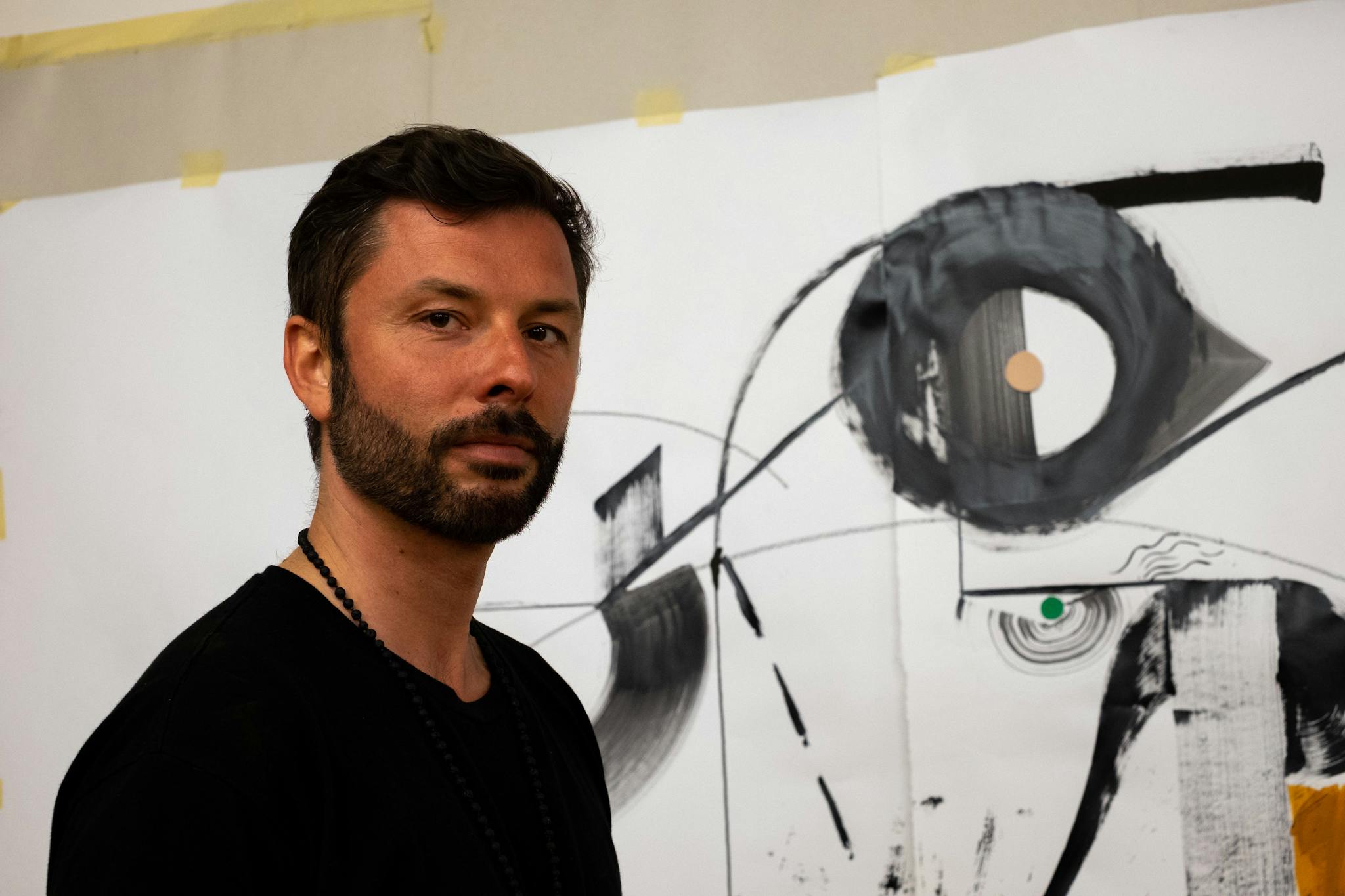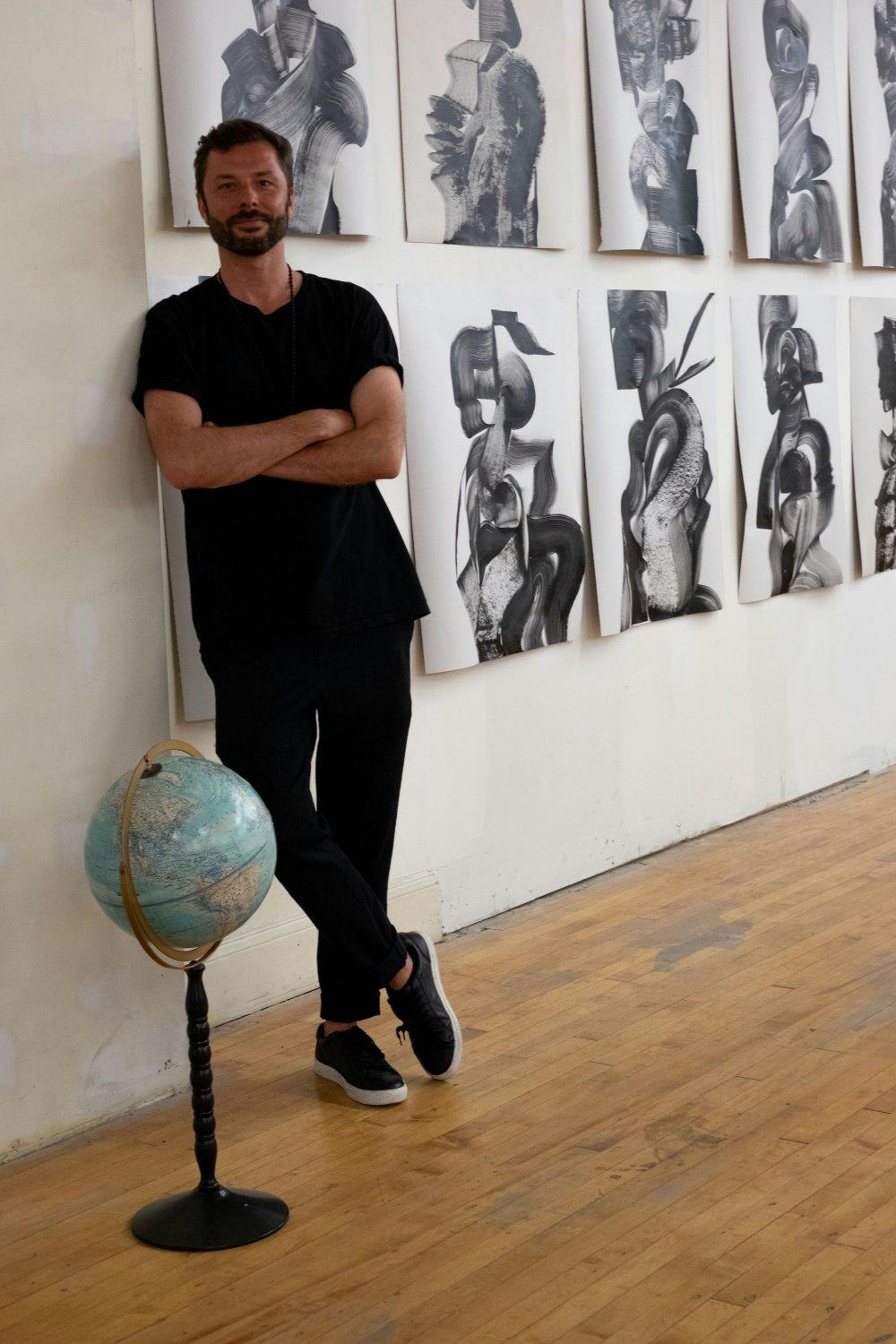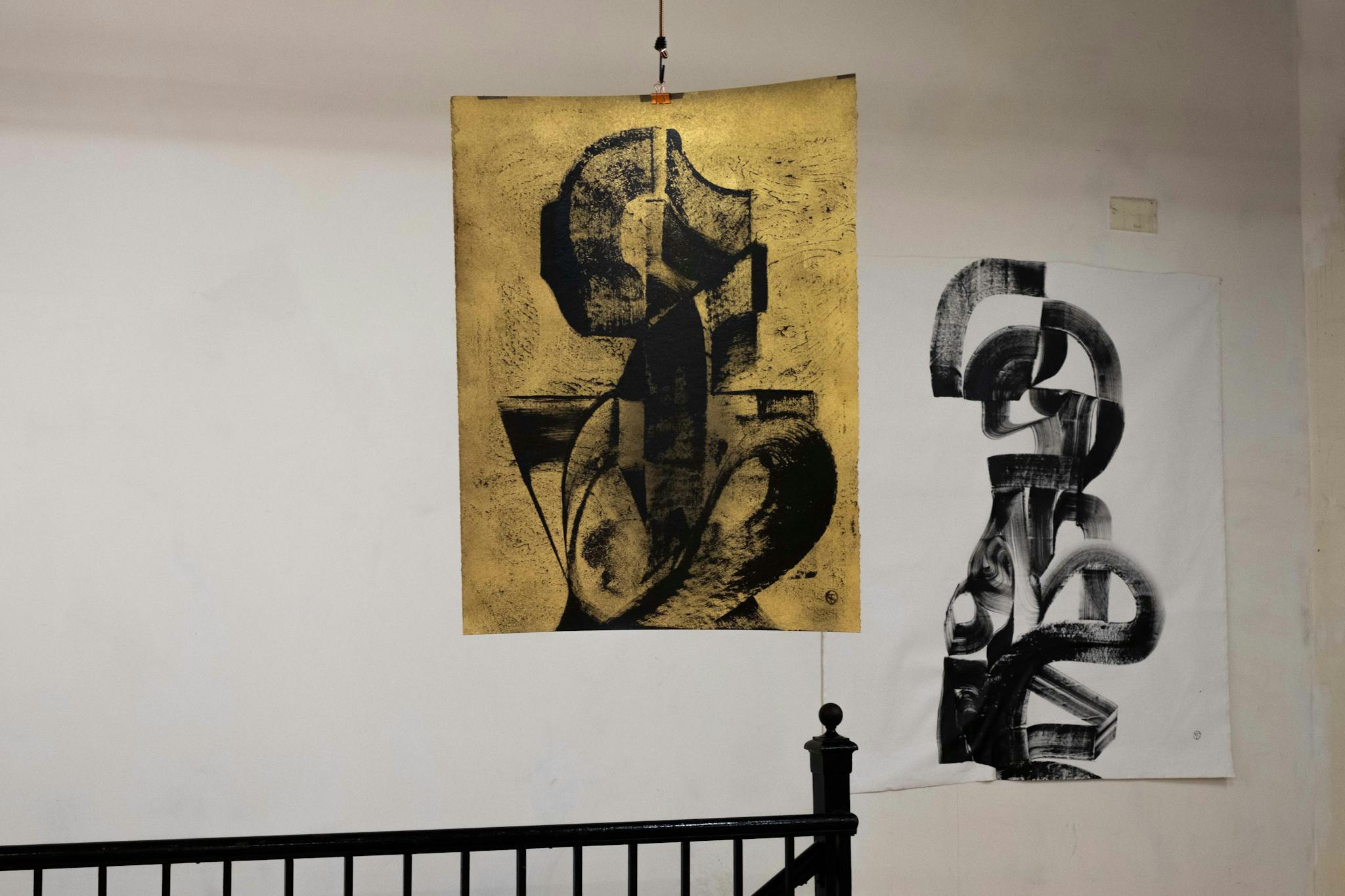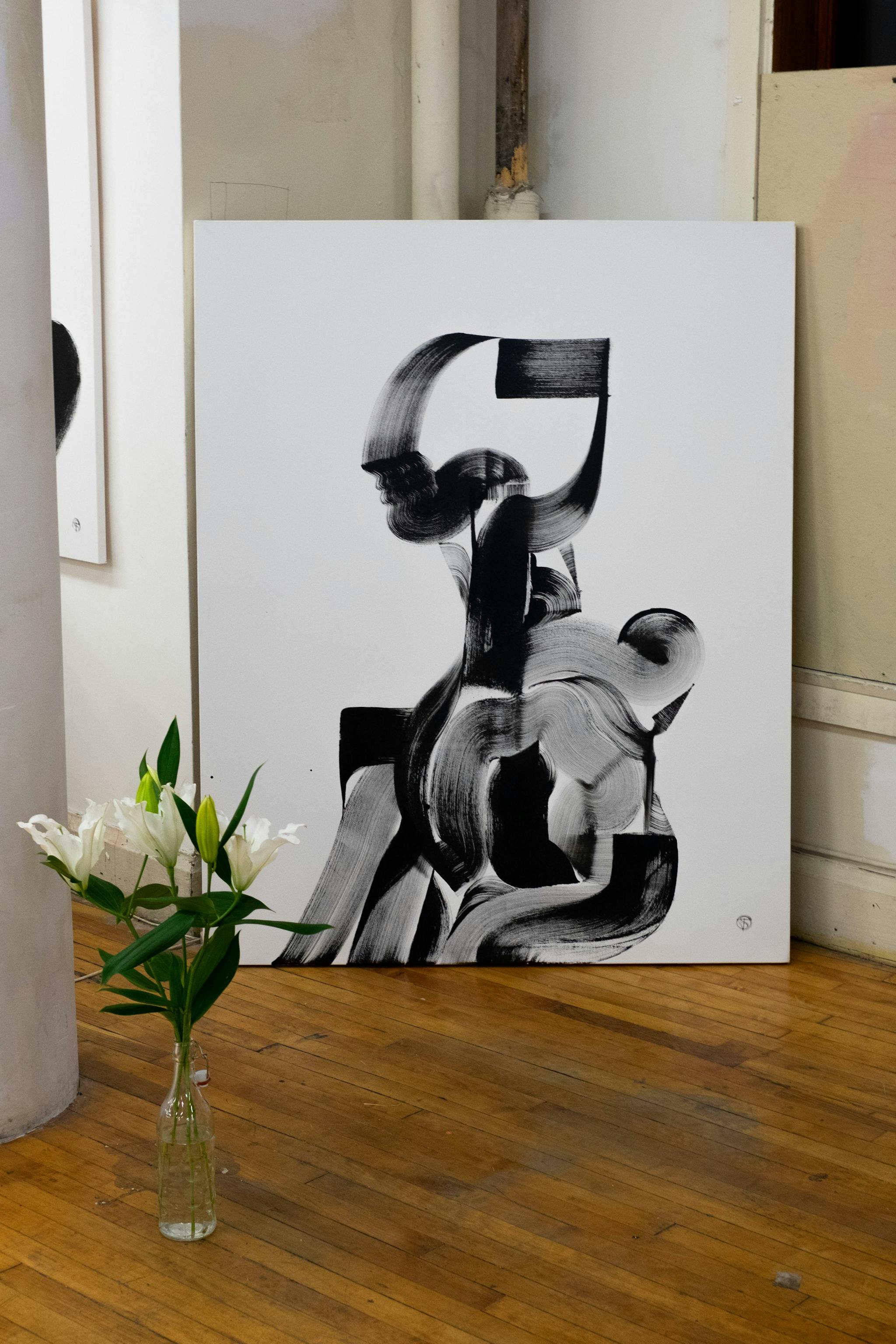Entering Tomek Sadurski’s studio in the heart of Chinatown was like arriving in a separate dimension dominated by the foreboding ring of Russian string orchestras and scent of Palo Santo. The floors are littered with almost 50 paintings that will go on to become his upcoming show, NAVIGATORS presented by A R E A Gallery. They appear fairly humanoid, but abstract enough to resemble a high-concept Rorschach test. It seems natural that Sadurski’s studio would have such a distinct flavor from what lies beyond it, though; how else do you feel at home in a place you’ve barely lived in for two months? For Sadurski, movement is not distressing – it’s inspiring. Born in Poland, based in Berlin and LA, and living in Boston as he unveils his new public art piece TIDES, the self-described draftsman and painter carries motion and its documentation throughout his work. I caught up with Sadurski before his show’s opening to discuss his new exhibitions and the primality and intuition that permeate them.
Online• Jun 03, 2018
In Conversation: Tomek Sadurski on “NAVIGATORS” and “TIDES”
Born in Poland, based in Berlin and LA, and living in Boston as he unveils his new public art piece “TIDES,” Tomek Sadurski documents motion in his work.
Interview by Phil Zminda
Tomek Sadurski with an image from NAVIGATORS. Photo by Mana Parker.

Tomek Sadurski with an image from NAVIGATORS. Photo by Mana Parker.

Tomek Sadurski with a selection of portraits from NAVIGATORS. Photo by Mana Parker.
Tell me about TIDES. “TIDES explores the beauty of motion and movement on the side of 10 Farnsworth in Fort Point. Considering it and the city of Boston revolve around its proximity to water, I created panel drawings that represented the push and pull of the water on the coast. I wanted to portray its movement and its mobility as if to reflect the movement of the ocean and the movement of people as they walk by it on the narrow street.” What was it like working with the developers and architects to get your work there? “The two groups that created the building, TCR Development and CBT Architects, were immensely supportive. I had a beautiful dialogue with the Architects, and the developers absolutely believe in implementing art in public spaces. I believe that they’re ready to collaborate with the art community as a whole, whether with individual artists or galleries. I think our relationship is an interesting marriage, in that important art or cultural institutions do not have that much support, so I think us artists should look somewhere else for it. Looking at Boston and the crazy development right now, I think it’s up to us to tell these developers, ‘Let’s collaborate. Give us space, give us a canvas, and we can create something that’s beneficial for us both.’”

Tomek Sadurski with TIDES at 10 Farnsworth. Photo courtesy of Kure Creative.
The core of your work is drawing, but much of your educational background and even the places your work has been shown lie in the fashion world. How do those two intersect for you? “I studied fashion before I went to Academy of Fine Arts in Munich, and for me it was interesting because that fashion program was quite uncommon: a combination of fashion communication and design. I’m interested in fashion as a medium; I think it’s relevant how it has an impact, how it generates new phenomenon yet comments on the things happening around it. The pre-social media fashion world was quite different in that it was not as democratic as it is now and was guarded by people who had much more to say with their approach to art. I was in particular fascinated by Belgian fashion, like Maison Margiela, because it was so conceptual in nature.” Why didn’t you pursue it for your career, then? “I went on to work at H&M as a print designer when I was a young student. I quickly realized it wasn’t a world I wanted to be a part of, but I still have a little nostalgia for that world that I wanted to participate in. That nostalgia comes through in my drawing, so I really enjoyed being able to explore that more.” I definitely see some fashion silhouettes come through in your new one-night-only painting exhibition,NAVIGATORS. How did these paintings come about? “I started going to the different art institutions in Boston shortly after I moved here to get a taste of what they had in their collection. What stuck to my mind were all the pictures of different individuals in classic portraiture that, to me, appear a little boring and too posed. So I decided to reimagine these images in my own way by making them intuitively – I didn’t sketch them out before I put them onto the paper or anything. Although I started with that concept, I enjoyed the method of making the pieces so much that I didn’t stick to it religiously. I wanted to leave the interpretation of the pieces up to the viewer. I feel like this is why I feel so drawn to drawing; I like that untold white space. It’s very literal compared to some others. Plus, in the act of drawing, like other mediums, there is this unoccupied space on the page that is very meaningful. Since drawing is such a straightforward art, I like to leave things up to interpretation.”

Tomek Sadurski, “NAVIGATORS,” 2018. Installation View, Gallery at artist’s studio. Photo by Mana Parker.

Tomek Sadurski, “Untitled,” 2018. Installation View, Gallery at artist’s studio. Photo by Mana Parker.
You recently did a collaborative project with FKA Twigs, who is one of my personal favorite musical artists. Did your dance drawings have anything to do with that? My friend Ryan Heffington, a choreographer based out of LA, texted me one day, “You need to meet this girl Twigs, I’ve worked with her before, she loves your drawings.” Then boom, I’m at a dinner with her, and she’s like, laughs “can you make my next poster?” And I had just seen the Two Weeks clip, so I was like, “are you kidding? Yes, absolutely yes!” I ended up going with them to the show I designed the posters for, Congregata, where Twigs put all of these incredible voguers from New York and they just burned the stage down. They just killed it; it was such a special experience. Boston is a pretty different beast from the places you usually spend time in like LA and Berlin. How does it compare for you? “The city still feels familiar to me because it reminds me of Munich. Boston feels like it’s the Munich of the US to me; it’s historical, it has this bourgeois touch, a huge population of universities, students, highly-educated people, and an intensely professional aura. I used to be obsessed with big cities. I wanted to feel the pulse of time. But I like how Boston lets me explore the zone in between; sometimes those big cities suffer under their own weight.” Definitely – they can be not fun because of how big they are. They can be overwhelming. “I wanted to see something disruptive and different in those cities; I was looking for more surprises. But I like the size of Boston at the same time. I like this spot here in Chinatown because it feels so authentic and visually untouched by the new real estate. There’s a lot of visual impact from the buildings here and surprising and interesting people.” You’ve created all around the globe, but if you could do it anywhere, where would you do it? “That’s a tricky question for me because a lot of fuel for my work comes from movement. I guess my ideal place would be a pod that could teleport me anywhere, so I could be in as many different places as I wanted.”

Tomek Sadurski. Photo by Mana Parker.
You can learn more about Tomek Sadurski on his Instagram and website. His new installation, TIDES, can be seen at 10 Farnsworth in Fort Point.
